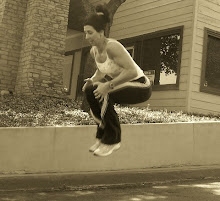Sunday, January 31, 2010
Friday, January 29, 2010
Constant Contact : Emails : Manage Archive
Constant Contact : Emails : Manage Archive: "http://archive.constantcontact.com/fs057/1102382223067/archive/1102973047776.html"
Lisa's success!

I want to recognize one of my clients: Lisa. At first she had pain and severe tightness in her hip, low back, glute, and down her leg. Her foot would also hurt. She could not run; lunges and squats hurt her leg and hip. There were so many exercises she could not do. Before coming to me she had been to the doctors, had some rehab and not much improvement.
I know she was frustrated. I kept working with her and 3 months later what a turn around.
She is doing plyo squat jumps, sprints on the treadmill, barbell squats, all types of planks and core work. I wanted to say how proud i am of her for hanging in long enough to get pain relieve with physical activity. Her pain is gone.
Thursday, January 28, 2010
Wednesday, January 27, 2010
Tuesday, January 26, 2010
What is Lactate Threshold?
Lactate is a product of rapid breakdown of glycogen and is
recyled back into reusable energy form by the liver and
muscle. Lactate does not cause fatique but instead tries
to slow it down. The fatique associated with lactate
accumulation actually comes from an imbalance of
ATP during vigorous exercise. When ATP use and
resynthesis are not in balance your body releases
hydrogen ions that cause the blood and muscle to
become more acidic. Muscles do not like to contract
in such an environment and the rate and stength
of the contraction will decrease unless buffering mechanisms
like lactate can bind and remove hydrogen ions.
Your body also gets rid of hydrogen ions thru carbon
dioxide: exhaling.
The rapid rate of beathing during intense exercise is the
body's attempt to utilize that buffer by quickly removing
carbon dioxide and thus hydrogen ions from bloodstream.
However, during extreme or prolonged vigoruous intense
exercise, there is a point or threshold where the hydrogen
ion release is greater than your body can buffer. This is
the point where fatique takes over and you can no
longer maintain that intensity!
To raise your threshold, you must increase the intensity
of your training. For example if fatique sets in at a rate of
170 BPM, you can increase training so fatique occurs at
172 BPM. To read the entire article pick up a copy of the
onfitness magazine, Jan 2009 issue page 38.
recyled back into reusable energy form by the liver and
muscle. Lactate does not cause fatique but instead tries
to slow it down. The fatique associated with lactate
accumulation actually comes from an imbalance of
ATP during vigorous exercise. When ATP use and
resynthesis are not in balance your body releases
hydrogen ions that cause the blood and muscle to
become more acidic. Muscles do not like to contract
in such an environment and the rate and stength
of the contraction will decrease unless buffering mechanisms
like lactate can bind and remove hydrogen ions.
Your body also gets rid of hydrogen ions thru carbon
dioxide: exhaling.
The rapid rate of beathing during intense exercise is the
body's attempt to utilize that buffer by quickly removing
carbon dioxide and thus hydrogen ions from bloodstream.
However, during extreme or prolonged vigoruous intense
exercise, there is a point or threshold where the hydrogen
ion release is greater than your body can buffer. This is
the point where fatique takes over and you can no
longer maintain that intensity!
To raise your threshold, you must increase the intensity
of your training. For example if fatique sets in at a rate of
170 BPM, you can increase training so fatique occurs at
172 BPM. To read the entire article pick up a copy of the
onfitness magazine, Jan 2009 issue page 38.
Subscribe to:
Posts (Atom)


